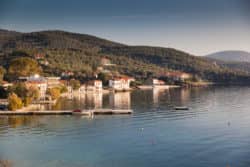About Pelion Peninsula, Greece
Pelion is a mountain that forms a hook-like peninsula between the Pagasetic Gulf and the Aegean Sea. The mountain of Pelion is densely  forested with beech, oak, chestnut, and maple trees. Around areas with water, pear, apple, and olive trees can be found. Pelion is abundant with water in the forms of rivulets, streams, springs, and gorges. The high elevations receive enough snowfall that there are skiing facilities.
forested with beech, oak, chestnut, and maple trees. Around areas with water, pear, apple, and olive trees can be found. Pelion is abundant with water in the forms of rivulets, streams, springs, and gorges. The high elevations receive enough snowfall that there are skiing facilities.
According to Greek mythology, Mount Pelion was the home of Chiron the Centaur, who was the tutor to Greek heroes including: Heracles, Theseus, Jason, and Achilles. The marriage of Thetis and Peleus took place on Mount Pelion near Chiron’s cave. The goddess Eris, having been upset at being left out of the party, showed up with a golden apple inscribed with “To the Fairest.” A dispute between Hera, Aphrodite, and Athena ensued and led to the Trojan War.
The first major investment in the Mount Pelion area was the Pelion railway, which dates back to 1892 -1903. Radios, automobiles, and electricity would be introduced in the 1950s, except for Volos, which had them earlier. Television would arrive throughout the 1970s and 1980s.
The 24 villages of Mount Pelion still keep the traditional Pelian architecture and construction. Buildings are made of stone using local green, blue, or grey slate and red clay. They are built on slopes that offer views of the surrounding area and sea. Pelian tradition says houses should be three stories: a ground level, which is used for work (kitchen, washing), the middle floor, which is for socializing, and the top floor for bedrooms. The interior of the houses usually consist of chestnut timber that is stained dark brown. Pelion mansions have been turned into hostels and boutique hotels.
Top Attractions in Pelion Peninsula, Greece
Moutzouris Steam Train – An old steam train known as Moutzouris (meaning smudgy). This train played a key role in the development of Pelion starting in the late 19th century. Visit the steam train in Millies.
Museum of Worry Beads – A unique museum featuring the history and variety of worry beads. The museum is located in the mountain village of Portaria. The location is charming with greenery, springs, old mansions, and cobblestone paths.
Church of Taxiarches – Located in Millies, this church was founded in the 17th century. Frescos in the church depict scenes from the bible. The Greek flag of Revolution was raised at this church in 1821.
Monastery of Agios Lavrentios – Established in 1378, this Byzantine monastery is located in Agios Lavrentios. The monastery was named after a monk named Lavrentios who founded it after living at Mount Athos. The monk is celebrated every August 15th and 16th with a large celebration and people coming from all parts of Greece.
Papa Nero Beach – Located next to the Agios Ioannis beach resort. Papa Nero Beach features white sand and torquoise waters. A popular beach that can become busy during the summer.
Horefto Beach – Located 2 km from Horefto, the seaport of Zagora. White sand and deep blue water make this beach especially beautiful. The beach is not organized, but the area has plenty of tourist facilities.
Church of Panagia – Located in Makrinitsa. This church was established in 1767 and is dedicated to the Assumption of the Virgin. The Church of Panagia features bells from Odessa and a tall bell tower.
Greek School Museum – An important educational center from the 18th century when Greece was under Ottoman occupation. The museum is located in Zagora. Famous Greek personalities studied at this school, which now showcases exhibits from the 16th – 19th century.
Museum of Folk Art – Located in Makrinitsa. The museum is housed in Topali mansion located below the central square. The mansion was built in 1844 and features items that depict life in Pelion.
Mylopotamos Beach – This white pebbled beach is located 52 km from Volos. This beach is divided in two with a path leading from one to the other. There are taverns and a beach bar nearby.

